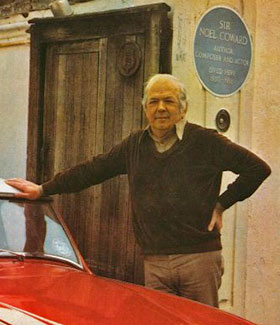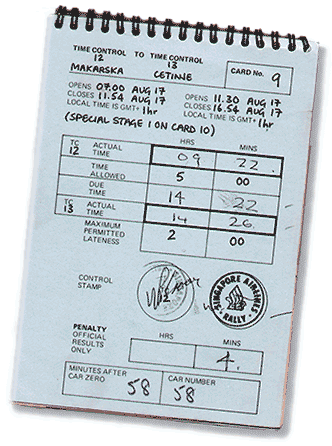Organising the 1977 London to Sydney Marathon
The 1977 Singapore Airlines London to Sydney Marathon had a very small organising team. Jim Gavin was the main man who made almost everything happen. Wylton Dickson was the over-lord, and Gail Finmark was the fiery dragon who said no to everything, the chief-beancounter, but who apart from the book-keeping was to keep well away from the rally-admin. There was also Candy Baker. Various other names were drafted in from time to time such Henry Liddon who was dispatched to check various sections of route. And that was it.

Wylton Dickson outside the Gerald Road rally headquarters
A large airy house at 7 Gerald Road in London's Belgravia, once the home of Noel Coward, was hired specially by Wylton to serve as the rally headquarters. It was now the home of Jim Gavin, who had a camp bed on the floor alongside the telex machine.
The Confederation of Australian Motorsport, CAMS, would step in and take charge of the Australian end of the event. As the boat docked late into Fremantle, talk of chopping the route was largely rejected except for cutting a short northen section to Darwin. In order to reach Sydney by the planned finish date the gruelling time schedule was now condensed into a super-gruelling time schedule running virtually non-stop from Perth to Sydney.
There were problems (every long-distance rally worth its salt has to have lots of problems). Rumours abounded that the late boat was because it had not been paid for by Wylton Dickson prior to the rally, or, that the shipping line now wanted more money, or, a bit of both. There were also more minor logistical problems… and with factory teams hell bent on winning, the pressures on the fragile organising team became horrendous.
The on-event team was assisted by a small band of travelling marshals, consisting of Martin Moorhead, Neil Crowe, Dr. John Teall (who was told he would only be paid as far as Madras – there was then a competitors petition to Wylton to persuade him to carry the doctor for the onward leg). Candy Baker, Jim Gavin, and Wylton Dickson, who did not get involved in the sordid affair of actually clocking cars in and out of controls. On top of this, there was the Australians – Ken Tubman was always willing to roll up his sleeves and work, however mundane the task, plus help from former BMC navigator Ron Crellin. Ron was also flying in and out where this was possible – and proved adapt at using airline schedules, for example, he flew out of Tehran to India in an aged ex-War War II Dakota, along with Neil Crowe and the Magenta driver, Philip Young, fresh out of a spell in an Iranian prison. The plane flew out of Tehran at night and straight into a violent electrical storm. As flashes of bright blue lightning lit up the wings, Crellin, staring out of the window, remarked loudly: “oh, look…I can see the rivets moving.”

Other help came from local motor-clubs, and an army of helpers was drafted in to man controls, and farm gates, once into Australia. The RAC’s Peter Cooper travelled along the event by air to compute the results, leap-frogging into major cities with his results equipment (a long piece of string and a bag full of clothes pegs – the string was run across a bedroom, like a washing line, the Time Card books, designed like shorthand notepapds with a wire binding across the top, were hung over the line in order of times taken, the line up adjusted until they were in the right order… fastest at one end, slowest the other end, and when it looked right, the results were then written down on one sheet of paper and stuck to a wall in the lobby of the hotel with a patch of gaffa-tape. Someone might, or might not, then telephone the list of results to London… the likes of Autosport, Motoring News, the Daily Mail who covered the event only because Philip Young of Car 2, the Magenta, worked on their News Desk, and other outlets seemed to get results at regular intervals. The “established” motor-sport media such as Autosport and Motoring News were pretty cool towards Wylton Dickson, and gave surprisingly little coverage in the run up to the event – in part due to Wylton’s rather unhappy relationship with one or two of the regular reporters of the international rally scene.
The Australian leg was run under the control of CAMS with Gus Staunton and Stuart McCleod present as Stewards to oversee proceedings. This was not exactly the makings of a happy marriage. For one thing, CAMS fined several competitors penalties in terms of points in the results for speeding, having set up their own speed-checks, on top of a string of radar checks set up by traffic police - some of these were in open country. A second offence for speeding, in their eyes, would have any competitor excluded from the results – this led tired crews to numerous protests at the very end of the event, just when it should have ended in high spirits. As it was, the penalties for exclusion were scrubbed, others were changed, and the net result of an mass-meeting to hear the protest that lasted a day and well into the night was that only their own rally champion, Ross Dunkerton, would be demoted down the leaderboard, ending up in 5th spot. Nobody else would have their position changed.
Other problems were simply bizarre – at one point, the route-book which had been measuring everything in kilometres from the Covent Garden start suddenly switched, without warning, to miles… a second car, and crew, had clearly been instructed to make the notes from that point on, and the error was never picked up. A trifling detail for those survivors who were still in the game for the final haul, non-stop, around Australia. Tony Fowkes was penalised 30 minutes for losing his route-book – a time penalty that didn’t ruin his remarkable second-overall placing.
Other glitches were such items as the marshals at the Warri Gate on the New South Wales / Queensland border went home early, not having been told that the opening and closing times had been extended – both Chris Bruce in the Freeway Escort, and journalist Evan Green, in a Range Rover, saw the marshals packing up and driving off as they came over the horizon. This issue, combined with the fact that the route instructions for the section to Warri Gate showed Menidee to Wilcannia as 27.60 kms while the true distance is closer to 150kms, was another subject of a protest at the end – with Paddy Hopkirk trying hard to prevent the penalties at this point from being cancelled…. he failed.
Australia was certainly tough. One car caught fire (Prive’s Range Rover) and turned into a molten mass of metal, the Chris Bruce Escort caught fire before Ayres Rock, but was able to continue, more than one car crashed into the outback, several cars hit kangaroos, with one crew hitting a kangaroo so hard it burst through the windscreen, which then had to be choked by stuffing route notes into its mouth… if these difficulties were not enough, ending it all amid long wrangles over penalties with officials from CAMS only confirmed that rallying is, sadly, sometimes a test of nerve even when the wheels have stopped turning.

